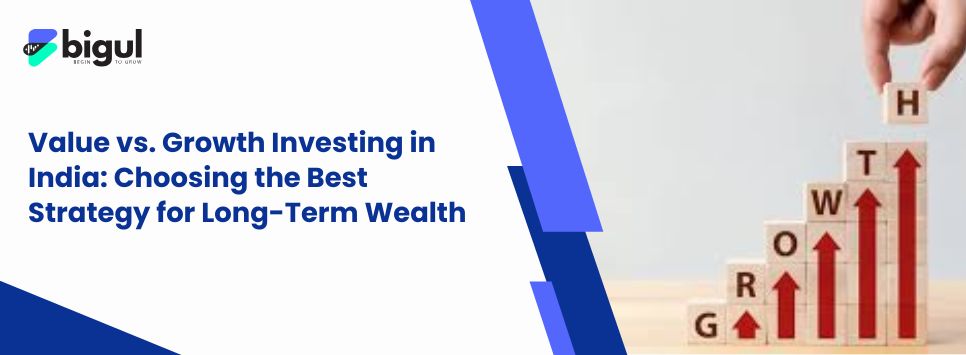When someone is building long-term wealth through Indian Stocks, there are two ways to do so: one is value investing, and the other is growth investing. Each type of this investing value has unique benefits.
Value investing in Indian stocks is related to buying undervalued stocks which has strong fundamentals. Some of the value investing equities have a low price to earnings ratio and a high dividend yield. It often offers stability and passive income to investors. The value investing strategy is popular among energy stocks, banking, and other financial sectors.
On the other hand, various investors go for growth investing in India. It majorly focuses on equities with high P/E ratios. Some of these equities have high earning potential. Some of these stocks are found in technology, chemicals and various emerging sectors
Understanding the difference between value stocks vs. growth stocks in India can help investors diversify their portfolio and maximise returns over time.
Also Read | GST Collections Rise 9.9% in March 2025 to Rs 1.96 Lakh Crore
Performance and Suitability of the growth investing and value investing
Growth investing equity stocks have outperformed various other sectors in terms of ROI. Recently, experts have suggested that value investing might see a revival in 2025. Given the current economic uncertainty, value investing might be a substantial plan. It makes a good fit for risk-averse investors who are looking to save for retirement. Growth stocks are suitable for investors who are looking to invest for a longer horizon and willing to take on low risk.
An interesting angle is that many experts believe that one should mix both strategies. This can hedge against market swings, like having both a fixed deposit and a startup investment, ensuring you capture opportunities across cycles.
A Detailed Analysis of Value Investing vs. Growth Investing
Understanding the nuances of value investing and growth investing are the two cornerstone strategies for long-term wealth-building.
The strategies exist to help stock market investors who deal with Indian market complexities. The following discussion analyses value investing definitions alongside advantages and disadvantages and emphasises performance metrics with specific attention to human application for regular readers.
Understanding Value Investing: The Steady Path in India
Value investment in India resembles the discovery of rare gems as it involves selecting Indian stocks that the marketplace values below their actual worth. Companies such as Coal India and other established organisations operate mainly within the energy, finance and consumer staples sectors.
As of recent data, Coal India has a P/E ratio of 7.10 and a dividend yield of 6.42%, indicating stability with lower price-to-earnings ratios (often 7-15) and higher dividend yields, making them attractive for steady income.
The strategy, rooted in principles by Benjamin Graham, focuses on buying stocks trading below their fair market value, betting on eventual market recognition. Historical data suggests value investing outperforms during economic downturns or high-inflation periods in India, such as 2022, when energy stocks like Coal India led. However, risks exist, as value stocks can be “value traps”—cheap for a reason, underperforming due to structural issues.
Investing based on value principles suits risk-averse patients who prefer long-term gains during times when markets take an unclear duration to recognise their value. This holds particularly true during technology-focused periods.
Exploring Growth Investing: The High-Flyer Approach in India
Contrastingly, growth investing in India is like backing a promising startup, targeting companies expected to grow earnings faster than average, often in technology stocks, chemical stocks, and pharmaceutical stocks. Think stocks , with a P/E ratio of 43.85 or tech giants like Infosys and TCS, which reinvest profits into expansion rather than paying dividends. These high-growth stocks often have P/E ratios above 25, reflecting strong growth expectations in the Indian stock market.
Growth stocks in India thrive in low-interest-rate environments, dominating key stock market indexes like the Nifty 50 and Sensex. Various investors have driven recent performance, a trend mirrored in India with leading tech stocks and consumer goods stocks.
Growth stocks in India exceeded value stocks similarly to worldwide markets according to recent data during the 2009-2020 market rise. Investors who want high returns together with long-term wealth-building strategies find value in these stocks.
The dangers of growth investment are severe because Indian growth stocks demonstrate substantial market volatility and react sharply to rising interest rates. It can experience steep drops when earnings projections fail to materialise. Experienced investors close to retirement, as well as risk-averse investors, should avoid these investments since they entail elevated risks for potentially larger rewards.
Comparative Analysis: Performance and Market Cycles in India
To aid decision-making, let’s compare using a detailed table, highlighting key metrics based on recent data:
|
Aspect |
Growth Investing in India |
Value Investing in India |
|
Definition |
Focus on stocks expected to grow quickly |
Focus on undervalued stocks with strong fundamentals |
|
P/E Ratio |
Often above 25 |
Typically 7-15 |
|
Dividends |
Low or zero |
Higher |
|
Volatility |
Higher compared to other stocks |
Lower compared to other stocks |
|
Historical Performance |
Outperformed value stocks recently, driven by bull markets |
Outperformed during downturns, like high inflation periods |
|
Market Conditions |
Excel in low-interest-rate environments, bull markets |
Performs well during high inflation and market corrections |
|
Pros |
High returns, rapid growth potential, dominate indexes |
Lower volatility, stable dividends, strong in downturns |
|
Cons |
Risk of plunges, interest rate sensitivity, short-term volatility |
Value traps, slow recognition, underperformance during tech booms |
Practical Considerations Before Choosing Your Investing Strategy
People decide between Indian value investing and Indian growth investing based on their risk opinions and future financial targets, and market expectations. The higher returns of growth investments match younger investors' aggressive long-term wealth-building plans, particularly during periods of low interest rates because of India's youth population and technological growth. Senior investors who prepare for retirement tend to select value due to its stability through dividends and reduced risk exposure the same way Coal India provides a 6.42% dividend yield. Experts suggest combining both investment options since they complement each other to build a well-diversified portfolio. Similar to fixed deposit and startup combination, the approach lets you enjoy the security benefits while taking advantage of investment development potentials. Periodic rebalancing helps your portfolio maintain its desired asset allocation by preventing excessive investments in volatile stocks or undervalued performs.
Conclusion: Building Wealth Your Way
Ultimately, value investing in India and growth investing in India are complementary tools for stock market investing, each with unique strengths for long-term wealth-building strategies using Indian stocks. Whether you lean toward the steady climb of undervalued stocks like Coal India it’s your journey. Starting with a mix, like planting seeds in different gardens, and adjusting over time can pave the way to financial success.

.jpg)






.jpg)
.jpg)
